Hua C., Wong R. Differential Equations and Asymptotic Theory in Mathematical Physics
Подождите немного. Документ загружается.

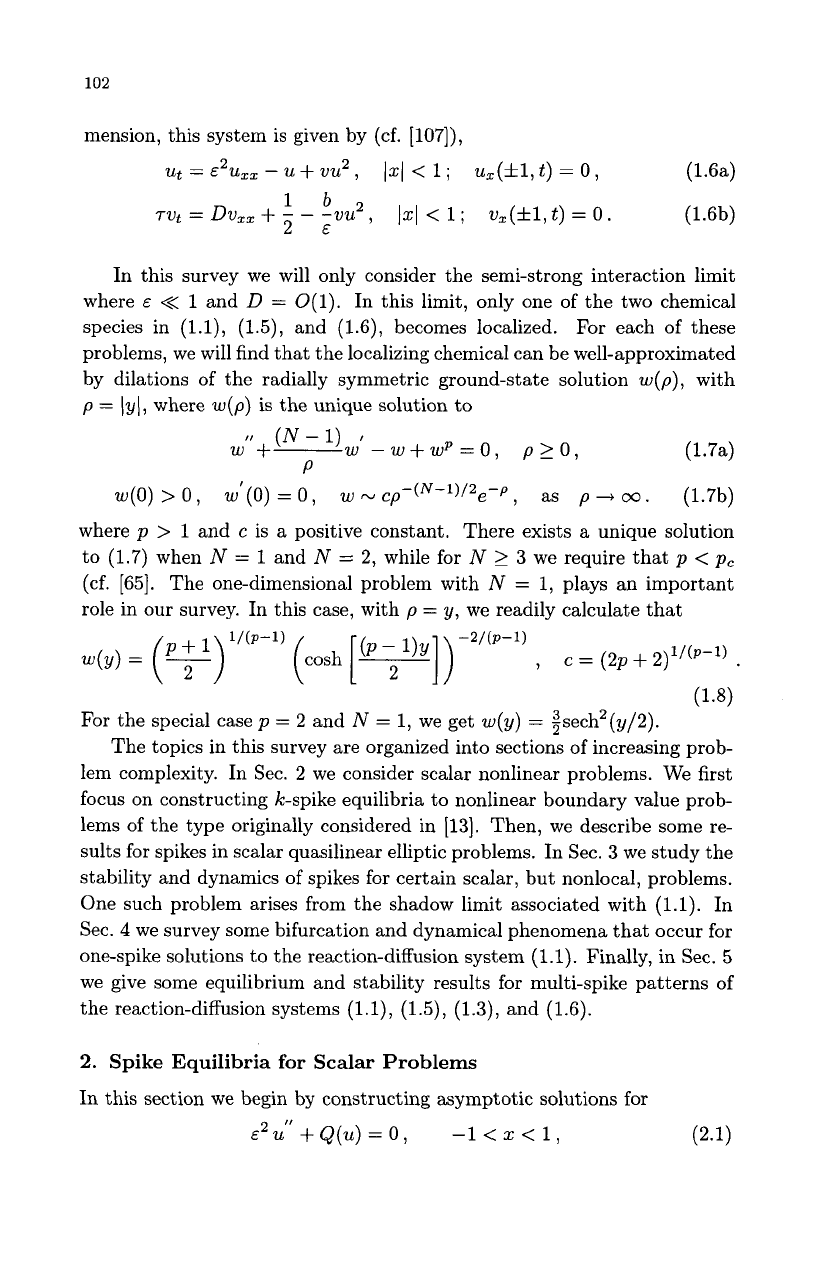
102
mension, this system is given by (cf. [107]),
ut
=
E
2
uzz
-
u
+
21212,
1x1
<
1
;
u,(fl,
t)
=
0,
(1.6a)
1b2
721t
=
DU,,
+
-
-
-wu
,
1x1
<
1
;
wz(fl,
t)
=
0
2E
(1.6b)
In this survey we will only consider the semi-strong interaction limit
where
E
<<
1
and
D
=
O(1).
In this limit, only one of the two chemical
species in (l.l), (1.5), and (1.6), becomes localized. For each of these
problems, we will find that the localizing chemical can be well-approximated
by dilations of the radially symmetric ground-state solution
w(p),
with
p
=
(yl,
where
w(p)
is the unique solution to
II
(N
-
1)
I
w
+-
w-
P
w+wp=o,
pLO,
(1.7a)
w(0)
>
0,
w'(0)
=
0,
w
N
cp-(N-1)/2e-p,
as
p
+
00.
(1.7b)
where p
>
1
and c is
a
positive constant.
There exists
a
unique solution
to (1.7) when
N
=
1
and
N
=
2,
while for
N
2
3
we require that
p
<
p,
(cf. [65].
The one-dimensional problem with
N
=
1,
plays an important
role in our survey. In this case, with
p
=
y,
we readily calculate that
For the special case p
=
2
and
N
=
1,
we get
w(y)
=
$ech2(y/2).
The topics in this survey are organized into sections of increasing prob-
lem complexity. In Sec.
2
we consider scalar nonlinear problems. We first
focus on constructing k-spike equilibria to nonlinear boundary value prob-
lems of the type originally considered in 1131. Then, we describe some re-
sults for spikes in scalar quasilinear elliptic problems. In Sec.
3
we study the
stability and dynamics of spikes for certain scalar, but nonlocal, problems.
One such problem arises from the shadow limit associated with (1.1). In
Sec.
4
we survey some bifurcation and dynamical phenomena that occur for
one-spike solutions to the reaction-diffusion system (1.1). Finally, in Sec.
5
we give some equilibrium and stability results for multi-spike patterns of
the reaction-diffusion systems
(l.l),
(1.5), (1.3), and (1.6).
2.
Spike Equilibria
for
Scalar Problems
In this section we begin by constructing asymptotic solutions
for
E~
u"
+
Q(u)
=
0,
-1
<
z
<
1
,
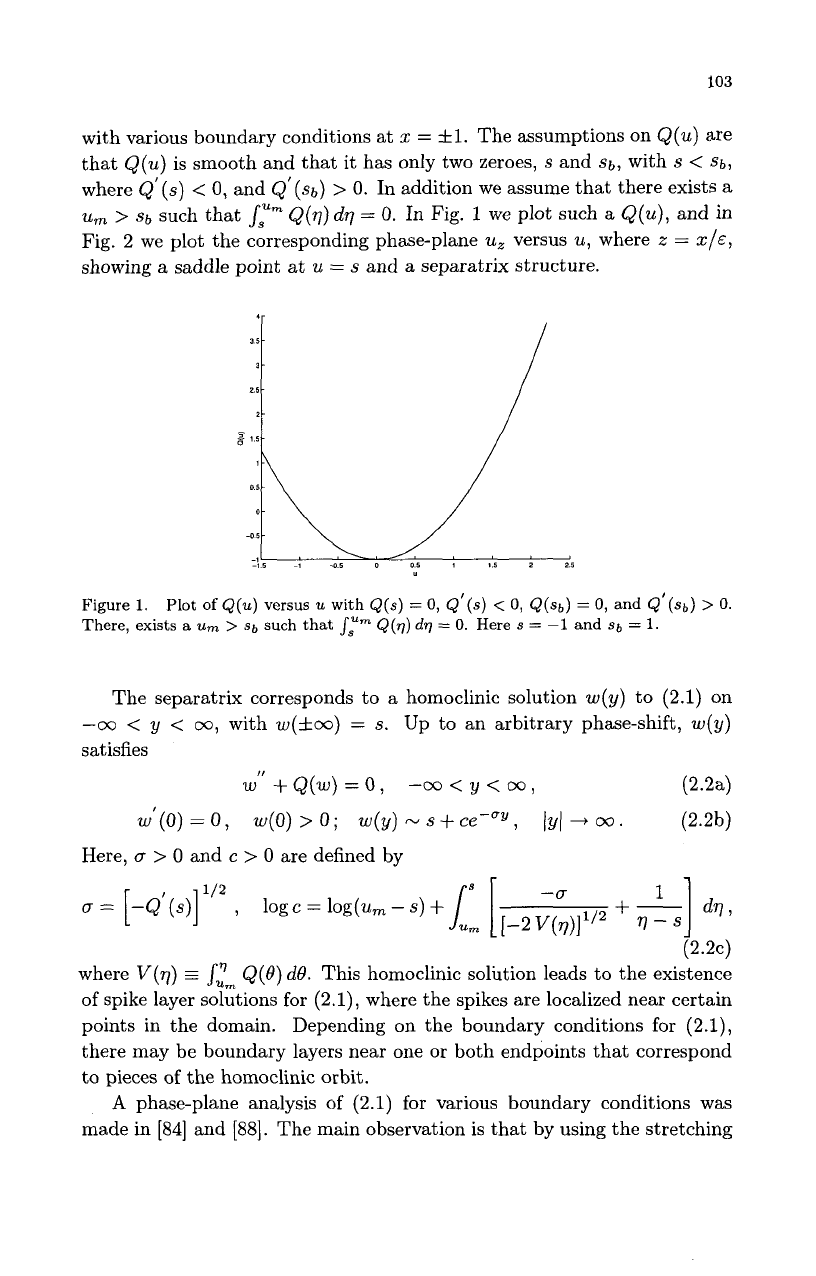
103
with various boundary conditions at
2
=
fl.
The assumptions on
Q(u)
are
that
Q(u)
is smooth and that it has only two zeroes,
s
and
sb,
with
s
<
Sb,
where
Q'(s)
<
0,
and
Q'(sb)
>
0.
In addition we assume that there exists
a
u,
>
sb
such that
ssu"
Q(q)
dq
=
0.
In Fig.
1
we
plot such
a
Q(u),
and in
Fig.
2
we plot the corresponding phase-plane
u,
versus
u,
where
z
=
Z/E,
showing a saddle point at
u
=
s
and
a
separatrix structure.
Figure
1.
There, exists
a
urn
>
Sb
such that
s,""
Q(q)
dg
=
0.
Here
s
=
-1
and
sb
=
1.
Plot
of
Q(u)
versus
u
with
Q(s)
=
0,
Q'(s)
<
0,
Q(Sb)
=
0,
and
Q'(sb)
>
0.
The separatrix corresponds to a homoclinic solution
w(y)
to
(2.1)
on
-00
<
y
<
00,
with
W(*CO)
=
s.
Up to an arbitrary phase-shift,
w(y)
satisfies
W"
+
Q(w)
=
0
,
(2.2a)
w'(0)
=
0,
w(0)
>
0;
w(y)
s
+
ce-OY
,
lyl
+
rn
.
(2.2b)
-CO
<
y
<
00
,
Here,
B
>
0
and
c
>
0
are defined by
where
V(q)
=
sJm
Q(0)
do.
This homoclinic solution leads to the existence
of spike layer solutions
for
(2.1),
where the spikes are localized near certain
points in the domain. Depending on the boundary conditions for
(2.1),
there may be boundary layers near one
or
both endpoints that correspond
to pieces
of
the homoclinic orbit.
A
phase-plane analysis
of
(2.1)
for various boundary conditions was
made in
[84]
and
[88].
The main observation is that by using the stretching
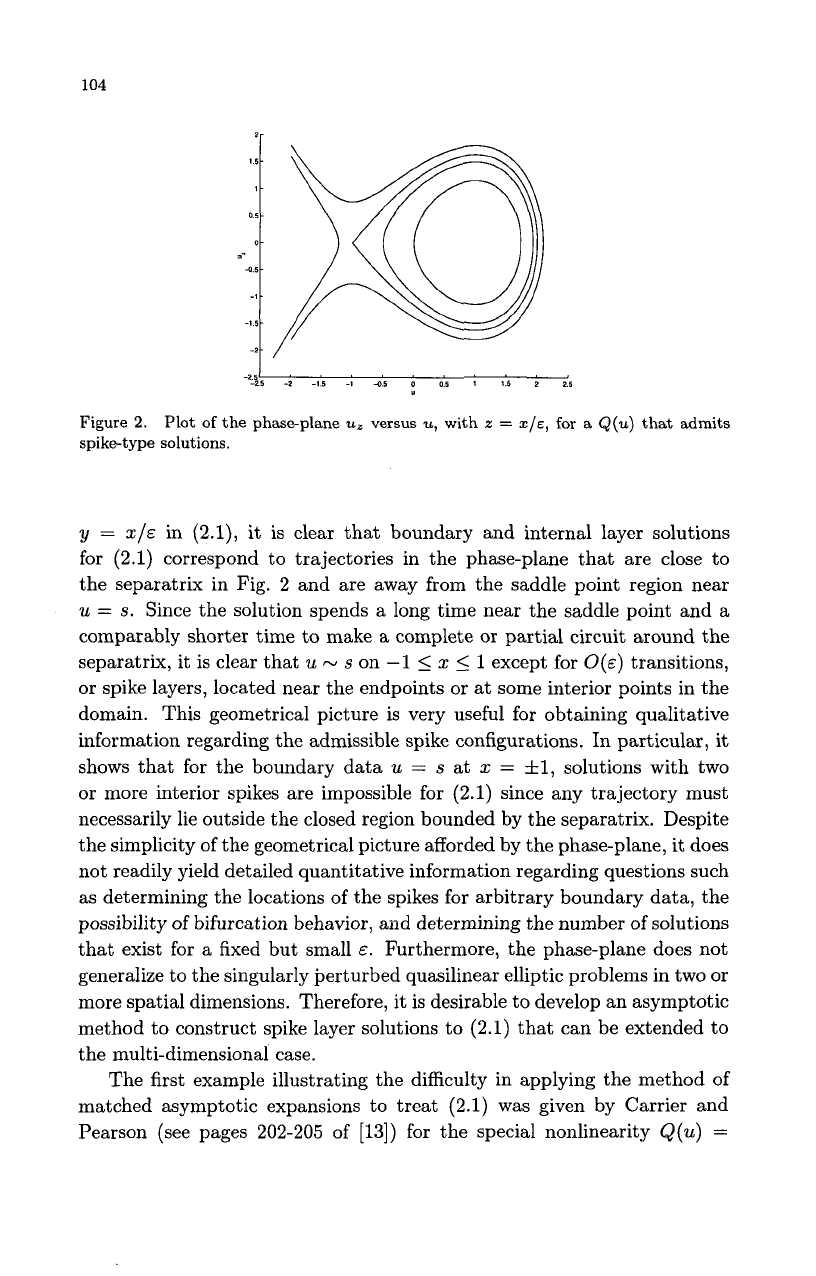
104
-251
"
'
" "
'
'
-25
-2
-15
-1
45
0 05
1
l5
2
25
Figure
2.
spike-type
solutions.
Plot
of
the phase-plane
uz
versus
u,
with
z
=
X/E,
for
a
Q(u)
that
admits
y
=
X/E
in (2.1), it is clear that boundary and internal layer solutions
for
(2.1)
correspond to trajectories in the phase-plane that are close to
the separatrix in Fig.
2
and are away from the saddle point region near
u
=
s.
Since the solution spends a long time near the saddle point and
a
comparably shorter time to make a complete
or
partial circuit around the
separatrix, it is clear that
u
N
s
on
-1
5
x
5
1
except for
O(E)
transitions,
or
spike layers, located near the endpoints or at some interior points in the
domain. This geometrical picture is very useful for obtaining qualitative
information regarding the admissible spike configurations. In particular, it
shows that
for
the boundary data
u
=
s
at
x
=
fl,
solutions with two
or
more interior spikes are impossible for (2.1) since any trajectory must
necessarily lie outside the closed region bounded by the separatrix. Despite
the simplicity of the geometrical picture afforded by the phase-plane, it does
not readily yield detailed quantitative information regarding questions such
as determining the locations of the spikes for arbitrary boundary data, the
possibility of bifurcation behavior, and determining the number of solutions
that exist for a fixed but small
E.
Furthermore, the phase-plane does not
generalize to the singularly perturbed quasilinear elliptic problems in two
or
more spatial dimensions. Therefore, it is desirable to develop an asymptotic
method to construct spike layer solutions to (2.1) that can be extended to
the multi-dimensional case.
The first example illustrating the difficulty in applying the method of
matched asymptotic expansions to treat (2.1) was given by Carrier and
Pearson (see pages 202-205 of [13]) for the special nonlinearity
Q(u)
=

105
u2
-
1,
and with
u(f1)
=
0.
For
this reason, we refer to
(2.1)
as Car-
rier’s problem. Near each endpoint there are two possible boundary layer
solutions. Superimposed on these boundary layer solutions, they tried to
construct a solution with one interior spike. However, as shown in
[13],
a
routine application of the method of matched asymptotic expansions fails
to determine the interior spike location
50.
In the vicinity of
z
=
ZO,
it is
easy to see that
u
has the form
u(.)
N
2w
[&-1(2
-
where
w(y)
is given in
(1.8)
with
p
=
2.
This failure in determining
50
is not
restricted to the choice
Q(u)
=
u2
-
1
but is typical for the class of problems
(2.1).
An extension of the method of matched asymptotic expansions was
used in
[66]
to determine the spike locations for
Q(u)
=
u2-
1.
There it was
shown that the failure of a routine application of the method of matched
asymptotic expansions in determining the spike locations was
a
result of
ignoring exponentially small terms in the expansion of the solution.
By
extending this method to retain and match the dominant exponentially
small terms, it
was
shown how to find the correct spike layer locations for
Q(u)
=
u2-1.
Another analytical approach to determine the spike locations
for
Q(u)
=
u2
-
1
was given in
[51].
They employed
a
variational principle,
with trial functions from the matched asymptotic expansion solution, and
determined the spike locations by making the variation stationary with
respect to the spike layer locations. More recently, for the nonlinearity
Q(u)
=
u2
-
1
a rigorous shooting method has been developed in
[85]
for
constructing spike layer solutions, and for determining the number of such
solutions for a fixed
E
with
E
<<
1.
Another rigorous approach based on
Green’s functions is given in
[52].
One limitation of these approaches are
that they rely heavily on analytical formulae that are available only for
Q(u)
=
u2
-
1,
and they are inherently methods that will work only in one
space dimension.
In
[loo],
an analytical method called the
projection
method,
was used to
determine the spike layer locations for
(2.1)
for various boundary conditions.
As shown in
[loo],
the indeterminacy in constructing interior spike solutions
for
(2.1)
is
a
result of the occurrence of exponentially small eigenvalues in
the spectrum of the linearized operator. In this sense, the linearized prob-
lem is exponentially ill-conditioned. The projection method, which com-
bines traditional matched asymptotic analysis with spectral theory, exploits
this exponential ill-conditioning by imposing limiting solvability conditions
on the solution to the linearized equation. In this sense the projection

106
method has much in common with
a
Lyapunov-Schmidt approach to study
the linearized equation. Although this method is formal, it does not require
any detailed knowledge of the explicit form of the homoclinic orbit and
so
can treat an arbitrary Q(u) of the form shown in Fig.
1.
In addition, it can
be extended to treat related problems in several space dimensions.
In addition to Carrier's problem, there are other classes of singularly
perturbed boundary-value problems where a straightforward application of
the method of matched asymptotic expansions fails to determine the
solu-
tion uniquely as a result of neglecting important exponentially small terms.
Such problems include boundary layer resonance phenomena for turning
point problems [67], heteroclinic interfaces in reaction-diffusion systems,
certain viscous shock waves for convection-diffusion problems, the Cahn-
Hillard equation etc. These problem are all exponentially ill-conditioned
and the projection method can be used to eliminate the indeterminacy.
A
survey of these other problems is given in [102].
2.1.
Interior Spike Solutions:
No
Boundary Layers
We now outline the projection method for constructing
a
solution to
E~U"
+
Q(u)
=
0,
EU'(~)
+
K,
[~(l)
-
S]
=
0;
-1
<
z
<
1,
EU'(-~)
-
~1
[u(-l)
-
S]
=
0,
(2.4a)
(2.4b)
with one interior spike and with no boundary layers near
x
=
fl.
Here
K,
2
0
and
~1
2
0
and
s
is the saddle-point location for Q(u). In the
phase-plane
u,
versus u, where
z
=
x/E,
these special boundary conditions
geometrically represent straight line segments originating from the saddle-
point
u
=
s.
Each of these lines is either locally inside or outside the loop
bounded by the separatrix. This geometrical fact will have an implication
regarding the location of
a
spike for (2.4).
The first step in the projection method is to look for an approximate
solution to (2.4) in the form
4.)
=
w
[E-yx
-
xo)]
+
R(z)
,
where
ZO,
with
1x01
<
1,
is to be found, and the error
R(x)
is assumed to
be small. We substitute (2.5) into (2.4) and linearize. Assuming that
zo
is
not
O(E)
close to
fl,
we can use the far-field behavior of
w(y)
in (2.2b) to
estimate the residuals in satisfying the boundary conditions in (2.4b). In
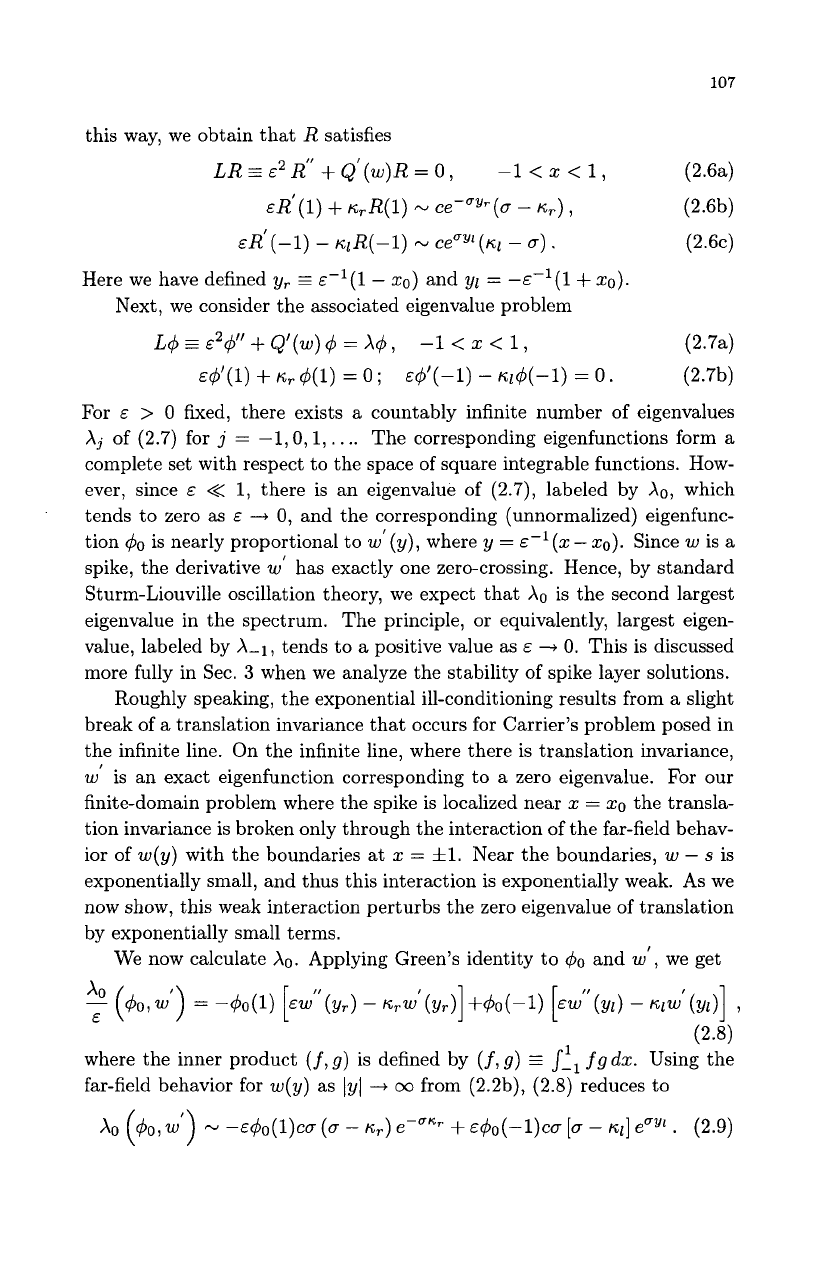
107
this way, we obtain that
R
satisfies
LR
E
E~
R”
+
Q’(~)R
=
0,
-1
<
2
<
1,
(2.6a)
ER’(I)
+
~i,~~(i)
ce-‘Yr(o
-
K,)
,
(2.6b)
(2.6~)
~~’(-11-
,QR(-I)
N
ce‘Yl(Pi,l
-
o)
.
Here we have defined
y,
--
~-l(1
-
20)
and
yl
=
-~-l(l+
ZO).
Next, we consider the associated eigenvalue problem
L$
~‘4’’
+
Q’(w)
4
=
A+,
-1
<
z
<
1,
(2.7a)
(2.7b)
For
E
>
0
fixed, there exists
a
countably infinite number of eigenvalues
Xj
of (2.7) for
j
=
-l,O,
1,.
. ..
The corresponding eigenfunctions form
a
complete set with respect to the space of square integrable functions. How-
ever, since
E
<<
l,
there is an eigenvalue of (2.7), labeled by
XO,
which
tends to zero
as
E
-+
0,
and the corresponding (unnormalized) eigenfunc-
tion
$0
is nearly proportional to
w‘(y),
where
y
=
~-‘(z
-
zo).
Since
w
is
a
spike, the derivative
w‘
has exactly one zero-crossing. Hence, by standard
Sturm-Liouville oscillation theory, we expect that
A0
is the second largest
eigenvalue in the spectrum. The principle, or equivalently, largest eigen-
value, labeled by
A-1,
tends to
a
positive value as
E
+
0.
This is discussed
more fully in Sec.
3
when we analyze the stability of spike layer solutions.
Roughly speaking, the exponential ill-conditioning results from
a
slight
break of
a
translation invariance that occurs for Carrier’s problem posed in
the infinite line. On the infinite line, where there is translation invariance,
w’
is an exact eigenfunction corresponding to
a
zero eigenvalue. For our
finite-domain problem where the spike is localized near
z
=
zo
the transla-
tion invariance is broken only through the interaction of the far-field behav-
ior of
w(y)
with the boundaries at
z
=
fl.
Near the boundaries,
w
-
s
is
exponentially small, and thus this interaction is exponentially weak. As we
now show, this weak interaction perturbs the zero eigenvalue of translation
by exponentially small terms.
E4’(1)
+
Pi,,
4(1)
=
0;
E$’(-l)
-
Qqq-1)
=
0.
We now calculate
Xo.
Applying Green’s identity to
40
and
w’,
we get
-
XO
(40,W’)
=
-400)
[EW”(Y,)
-
KrW’(Yr)]+40(-1) [EW”(Yl)
-
KlW’(Yl)]
I
E
(2.8)
where the inner product
(f, g)
is defined by
(f,
g)
--
J:l
fg
dz.
Using the
far-field behavior for
w(y)
as
IyI
-+
00
from (2.2b), (2.8) reduces to
XO (40,
w’)
N
-E~O(~)CU
(o
-
K,)
e-unr
+
~+o(-l)co
[o
-
~l]
euyl
.
(2.9)

108
To determine
&(&l),
we use boundary layer theory to calculate
90
as
4o(x)
=
W'
[~-l(x
-
xo)]
+
@r[E-l(l-
.)I
+
$l[~-l(x
+
I)]
7
(2.10)
where
dl(q)
-+
0
and
$,.(q)
-+
0
as
q
-+
+ca.
Since
Q'(u)
-
Q'(s)
=
-az
near x
=
fl,
we calculate from (2.1) that
q!~l(q)
=
blecUQ
and
&(Q)
=
b,.e-'q
for some coefficients
bl
and
b,.
to be determined. We then substitute
(2.10) into the boundary conditions (2.7b), and we use the far-field behavior
(2.2b) to calculate
w'
at x
=
fl.
In this way we determine
bl
and
b,,
and
from this we calculate
Substituting (2.11) into (2.9), and using (2.10) to asymptotically evaluate
(40,
w')
N
E
s-",
W'~(Y)
dy,
we obtain the following result:
Proposition
2.1.
For
E
<<
1,
the spectrum
of
the linearized problem
(2.6)
around a one-spike solution has an exponentially small eigenvalue
A0
with
where y,
=
E-'(
1
-
20)
and yl
=
-E-~
(1
+
50).
The corresponding eigen-
function
40
is given by
(2.10).
Next, we select the correct value of
xo
by imposing
a
limiting solvability
condition on the solution to the linearized problem. We expand
R
in (2.6)
in terms of the normalized eigenfunctions
4j
of (2.7). Using Green's second
identity, we readily derive that
(2.13)
Since
A0
-+
0
as
E
-+
0,
a necessary condition for
(2.6)
to
have a solution in
this limit is that
Co
-+
0
as
E
-+
0.
This limiting solvability condition, which
ensures that the projection of the error
R
onto the eigenspace associated
with the exponentially small eigenvalue is zero, yields an equation for
50.
Setting
Co
=
0,
and using (2.11) for
&,(fl),
we obtain that
-e-zgYr
(a
-
"r)
-
ezoYi
(~1-
a)
a
+
K,
0
+
Kl
Solving (2.14) for
50,
we obtain the following result:
(2.14)
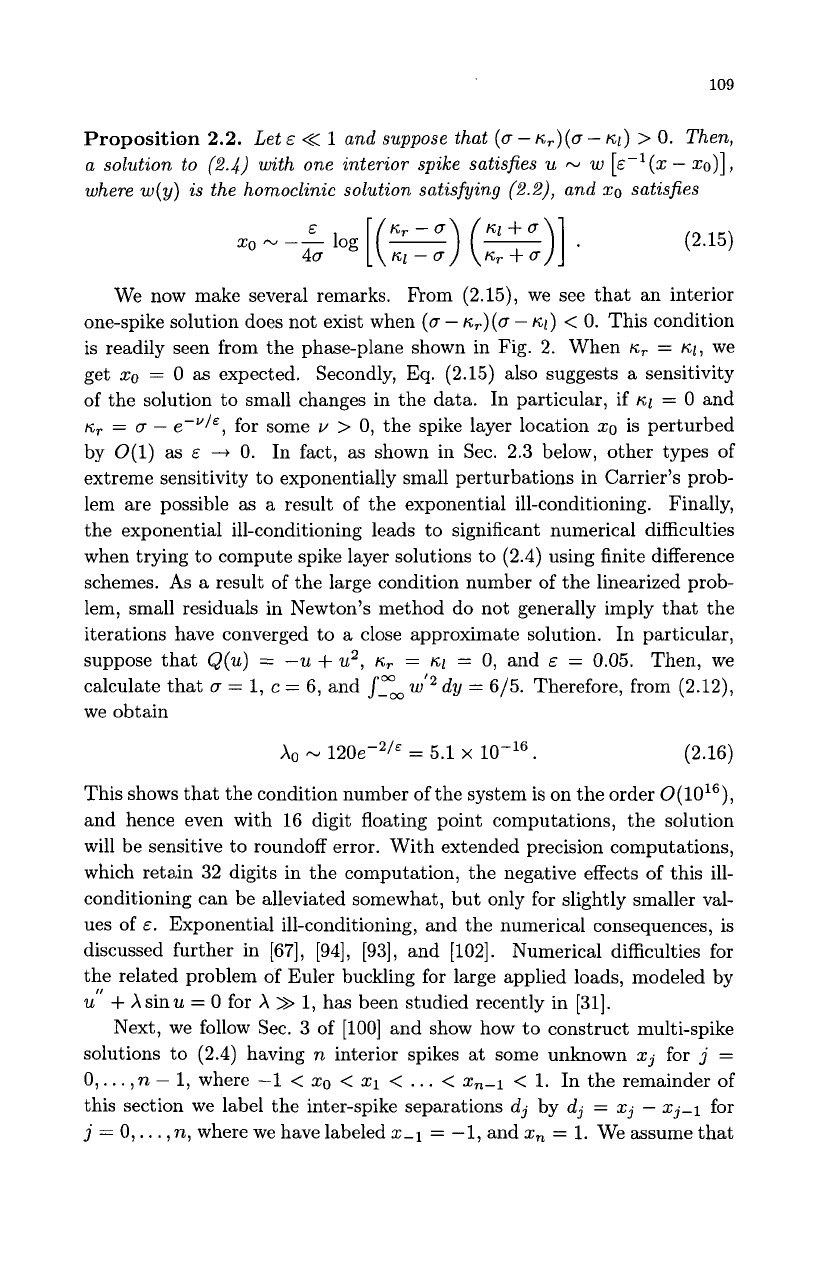
109
Proposition
2.2.
Let
E
<<
1
and suppose that
(a
-
&,)(a
-
fii)
>
0.
Then,
a solution to
(2.4)
with one interior spike satisfies
u
-
w
[E-~(X
-
xo)]
,
where w(y) is the homoclinic solution satisfying
(2.2),
and
xo
satisfies
zo
-
--
E
log
[(')
(-)I
K1
+
0
.
40
IE1-a
&+a
(2.15)
We now make several remarks. From (2.15), we see that an interior
one-spike solution does not exist when
(a
-
K,)(c
-
fit)
<
0.
This condition
is readily seen from the phase-plane shown in Fig. 2. When
IE,
=
fil,
we
get
zo
=
0
as
expected. Secondly,
Eq.
(2.15) also suggests
a
sensitivity
of the solution to small changes in the data. In particular, if
fil
=
0
and
fir
=
a
-
e--v/E, for some
v
>
0,
the spike layer location
xo
is perturbed
by 0(1) as
E
-i
0.
In fact, as shown in Sec. 2.3 below, other types of
extreme sensitivity to exponentially small perturbations in Carrier's prob-
lem are possible
as
a result of the exponential ill-conditioning. Finally,
the exponential ill-conditioning leads to significant numerical difficulties
when trying to compute spike layer solutions to (2.4) using finite difference
schemes.
As
a
result
of
the large condition number of the linearized prob-
lem, small residuals in Newton's method do not generally imply that the
iterations have converged to
a
close approximate solution. In particular,
suppose that
Q(u)
=
-u
+
u2,
IE,
=
KL
=
0,
and
E
=
0.05. Then, we
calculate that
(T
=
1,
c
=
6, and
s-",
w'~
dy
=
6/5. Therefore, from (2.12),
we obtain
XO
-
120e-2/E
=
5.1
x
(2.16)
This shows that the condition number of the system is on the order
0(1Ol6),
and hence even with 16 digit floating point computations, the solution
will be sensitive to roundoff error. With extended precision computations,
which retain 32 digits in the computation, the negative effects of this ill-
conditioning can be alleviated somewhat, but only for slightly smaller val-
ues of
E.
Exponential ill-conditioning, and the numerical consequences, is
discussed further in [67], [94],
[93],
and [102]. Numerical difficulties for
the related problem of Euler buckling for large applied loads, modeled by
U"
+
Xsinu
=
0
for
X
>>
1,
has been studied recently in [31].
Next, we follow Sec.
3
of
[loo]
and show how to construct multi-spike
solutions to (2.4) having
n
interior spikes at some unknown
xj
for
j
=
0,.
. .
,
n
-
1,
where
-1
<
xo
<
x1
<
. . .
<
x,-1
<
1. In the remainder of
this section we label the inter-spike separations
dj
by
dj
=
xj
-
xj-1 for
j
=
0,.
. .
,
n,
where we have labeled
5-1
=
-1,
and
x,
=
1. We assume that
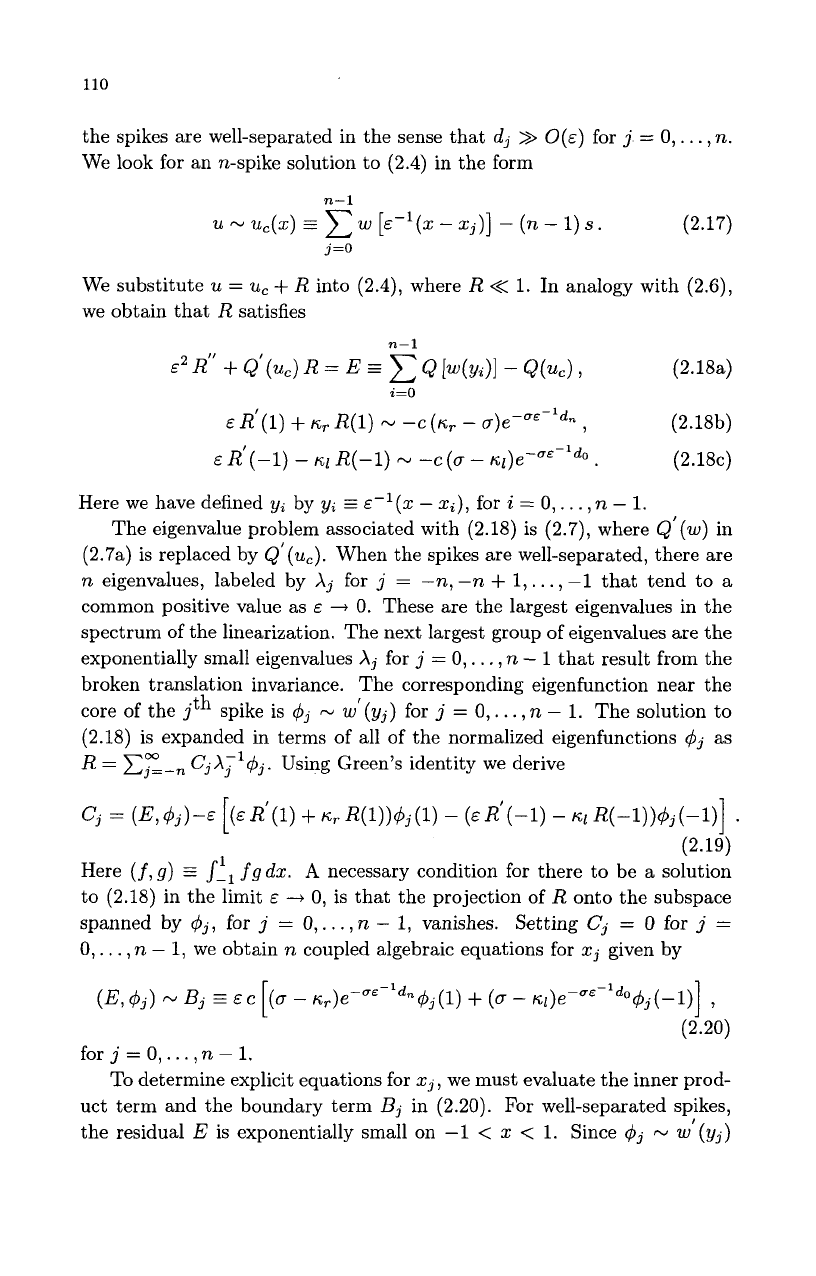
110
the spikes are well-separated in the sense that
dj
>>
O(E)
for
j
=
0,.
.
.
,n.
We look for an n-spike solution to (2.4) in the form
n-1
u
N
uc(z)
3
C
w
[~-l(z
-
xj)]
-
(n
-
1)
s.
We substitute
u
=
u,
+
R into (2.4), where R
<<
1.
In analogy with (2.6),
we obtain that R satisfies
(2.17)
j=O
n-1
E’
R“
+
Q’(uc)
R
=
E
C
Q
[~(yi)]
-
Q(uC),
--c
(K,
-
a)e-uE-ldn
,
(2.18a)
(2.18b)
(2.18~)
i=O
E
~’(1)
+
K,.
~(1)
E
R’(-1)
-
KL
R(-1)
N
-C(O
-
~l)e-~~-~~~.
Here we have defined
yi
by
yi
=
~-‘(z
-
xi),
for
i
=
0,.
.
.
,
n
-
1.
The eigenvalue problem associated with (2.18) is (2.7), where
Q’(w)
in
(2.7a) is replaced by
Q’(uc).
When the spikes are well-separated, there are
n eigenvalues, labeled by
Xj
for
j
=
-n,-n
+
l,.. .,-1 that tend to
a
common positive value as
E
+
0.
These are the largest eigenvalues in the
spectrum of the linearization. The next largest group of eigenvalues are the
exponentially small eigenvalues
Xj
for
j
=
0,
.
.
,
,
n
-
1
that result from the
broken translation invariance.
The corresponding eigenfunction near the
core of the
jth
spike is
$j
N
w’(yj)
for
j
=
0,.
.
.
,n
-
1. The solution to
(2.18) is expanded in terms of all of the normalized eigenfunctions
$j
as
R
=
C,”_-,
CjXi’q+.
Using Green’s identity we derive
Cj
=
(E,$j)--&
[(&R’(l)
+
~~R(l))$j(l)
-
(&R’(-l)
-
~iR(--l))$j(-l)]
.
(2.19)
Here
(f,g)
=
J!l
fgdx.
A
necessary condition for there to be a solution
to (2.18) in the limit
E
-+
0,
is that the projection of R onto the subspace
spanned by
$j,
for
j
=
0,.
. .
,
n
-
1,
vanishes.
Setting
Cj
=
0
for
j
=
0,
.
,
.
,
n
-
1,
we obtain
n
coupled algebraic equations for
xi
given by
(E,
4j)
N
B~
=
E-c
[(a
-
tcr)e-us-”n$j(1)
+
(a
-
Kl)e
-uE-ldo4j(-1)]
,
(2.20)
forj=O,
...,
n-1.
To determine explicit equations for
xj
,
we must evaluate the inner prod-
uct term and the boundary term
Bj
in (2.20). For well-separated spikes,
the residual
E
is exponentially small on
-1
<
z
<
1. Since
$j
N
w’(yj)
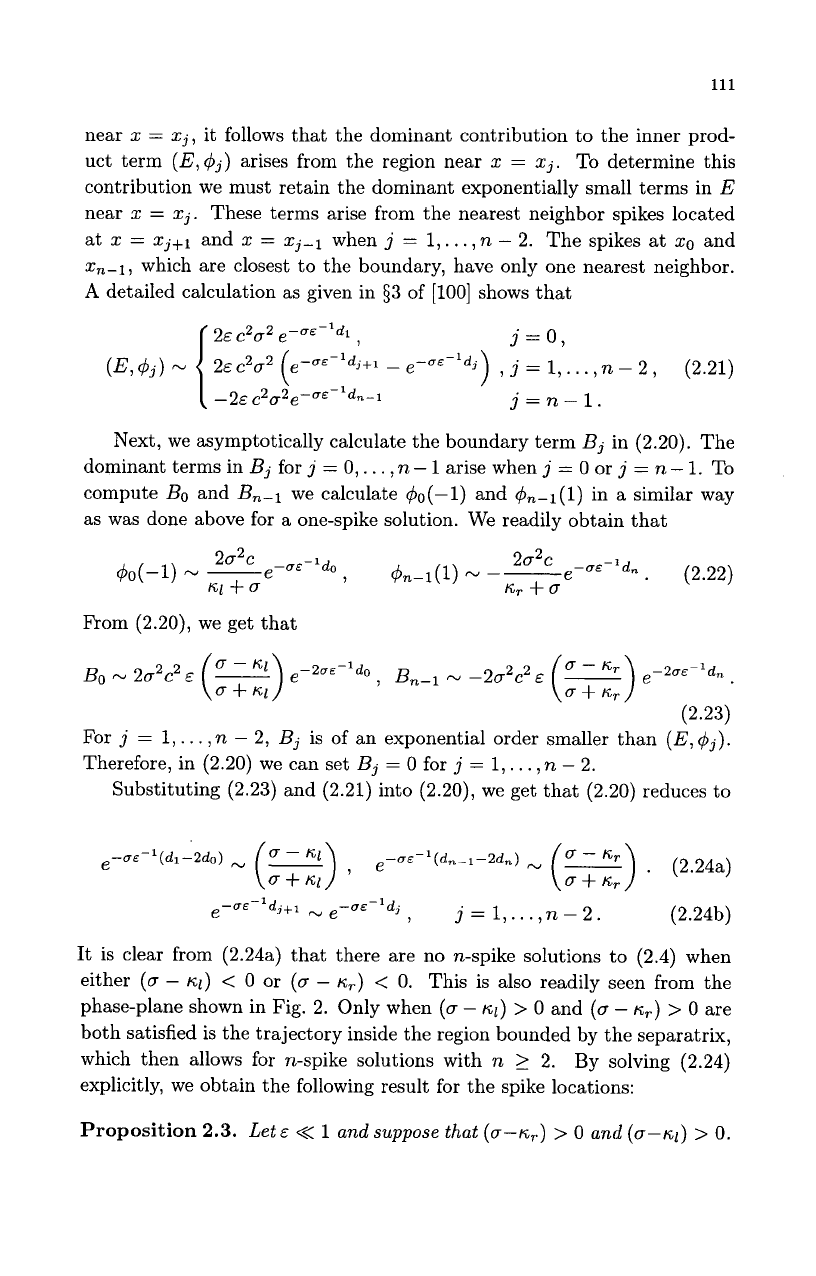
111
near
x
=
xj,
it follows that the dominant contribution to the inner prod-
uct term
(El&)
arises from the region near
x
=
xj.
To determine this
contribution we must retain the dominant exponentially small terms in
E
near
x
=
xj.
These terms arise from the nearest neighbor spikes located
at
x
=
xj+1
and
x
=
xj-1
when
j
=
1,.
. .
,
n
-
2. The spikes
at
xo
and
x,-1,
which are closest to the boundary, have only one nearest neighbor.
A
detailed calculation as given in $3 of
[loo]
shows that
I
j=O,
2E
c202
e-uE-ldl
(~~4~)
-
2EC202
(e-u~-ldj+i
-
e-UE-ldj)
,
J
.
=
1,.
.
.
,n
-
2
,
(2.21)
{
-2E
C2D2e-uE-1dn-i
j=n-1.
Next, we asymptotically calculate the boundary term
Bj
in (2.20). The
dominant terms in
Bj
for
j
=
0,
. . .
,
n
-
1
arise when
j
=
0
or
j
=
n
-
1.
To
compute
Bo
and
B,-1
we calculate
+0(-1)
and
q5,-1(1)
in
a
similar way
as was done above for a one-spike solution. We readily obtain that
From (2.20), we get that
For
j
=
1,
. .
.
,
n
-
2,
Bj
is
of
an exponential order smaller than
(E,
4j).
Therefore, in (2.20) we can set
Bj
=
0
for
j
=
1,.
. .
,
n
-
2.
Substituting (2.23) and (2.21) into (2.20), we get that (2.20) reduces to
e-~~-1(d1-2do)
e-~~-'(dn-1-2d,)
(zi;:)
.
(2.24a)
dj
,
j
=
1,...,n-2. (2.24b)
It is clear from (2.24a) that there are no n-spike solutions
to
(2.4) when
either
(cr
-
KI)
<
0
or
(cr
-
K~)
<
0.
This is also readily seen from the
phase-plane shown in Fig.
2.
Only when
(0
-
KI)
>
0
and
(cr
-
K~)
>
0
are
both satisfied is the trajectory inside the region bounded by the separatrix,
which then allows for n-spike solutions with n
L
2. By solving (2.24)
explicitly, we obtain the following result for the spike locations:
e-u~-ldj+l
e-uE-l
Proposition
2.3.
Lets
<<
1
and
suppose
that
(cr-~,.)
>
0
and
(0-6~1)
>
0.
